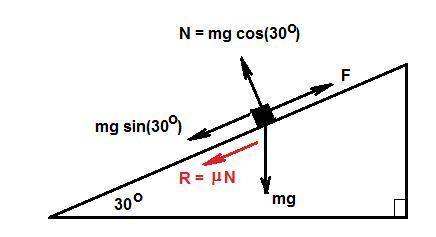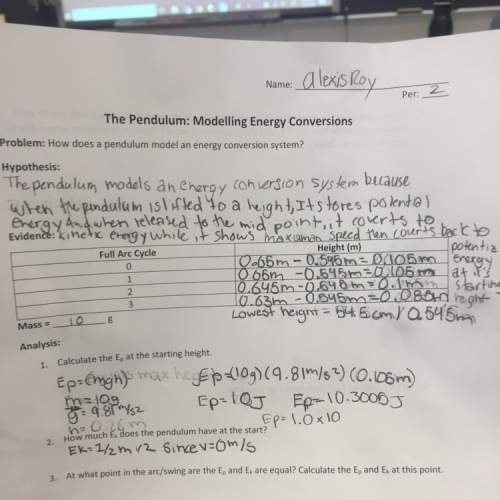
Physics, 18.07.2019 15:30, courtneymccl
I've got an energy and work problem. the premise of the problem is: a crate with a mass of m is on a ramp that is inclined at an angle of 30° from the horizontal. a force with a magnitude of f directed parallel to the ramp is used to pull the crate with a constant speed up the ramp a distance of d. there are a set of subquestions and i've answered them as best as i can, but i don't think i'm right. could someone give me the answers and me understand why i'm wrong? 1. what is the work done on the crate by the applied force f? --i said cos30 * f * displacement 2. 2. what is the work done on the crate by the gravitational force exerted on the crate by earth? --i said m*9.8*tan30 3. what is the work done on the crate by the normal force, with a magnitude of fn, exerted on the crate by the ramp? (hint: recall that the normal force is perpendicular to the surface of the ramp.) --i said zero 4. what is the work done on the crate by the frictional force fk? --i don't understand this one 5. what is the total force acting on the crate? --i said f, as in the pre-defined force 'f' 6. what is the work done on the crate by the total force? --i don't understand how this is different from the first one

Answers: 1
Other questions on the subject: Physics

Physics, 21.06.2019 14:50, justinb0829
Use the empirical rule. the mean speed of a sample of vehicles along a stretch of highway is 70 miles per hour, with a standard deviation of 4 miles per hour. estimate the percent of vehicles whose speeds are between 66 miles per hour and 74 miles per hour. (assume the data set has a bell-shaped distribution.)
Answers: 3

Physics, 22.06.2019 06:20, jonmorton159
Clothing made of several thin layers of fabric with trapped air in between, often called ski clothing, is commonly used in cold climates because it is light, fashionable, and a very effective thermal insulator. so it is no surprise that such clothing has largely replaced thickand heavy old-fashioned coats. (a) consider a jacket made of five layers of 0.1-mm-thick synthetic fabric (k = 0.13 w/m·°c) with 1.5-mm-thick air space (k = 0.026 w/m·°c) between the layers. assuming the inner surface temperature of the jacket to be 28°c and the surface area to be 1.25 m2, determine the rate of heat loss through the jacket when the temperature of the outdoors is 0°c and the heat transfer coefficient at the outer surface is 25 w/m2·°c. (b) what would your response be if the jacket is made of a single layer of 0.5-mm-thick synthetic fabric? what should be the thickness of a wool fabric (k = 0.035 w/m·°c) if the person is to achieve the same level of thermal comfort wearing a thick wool coat instead of a five-layer ski jacket?
Answers: 1

Do you know the correct answer?
I've got an energy and work problem. the premise of the problem is: a crate with a mass of m is on...
Questions in other subjects:



English, 13.06.2020 21:57



Social Studies, 13.06.2020 21:57

Chemistry, 13.06.2020 21:57



Chemistry, 13.06.2020 21:57








